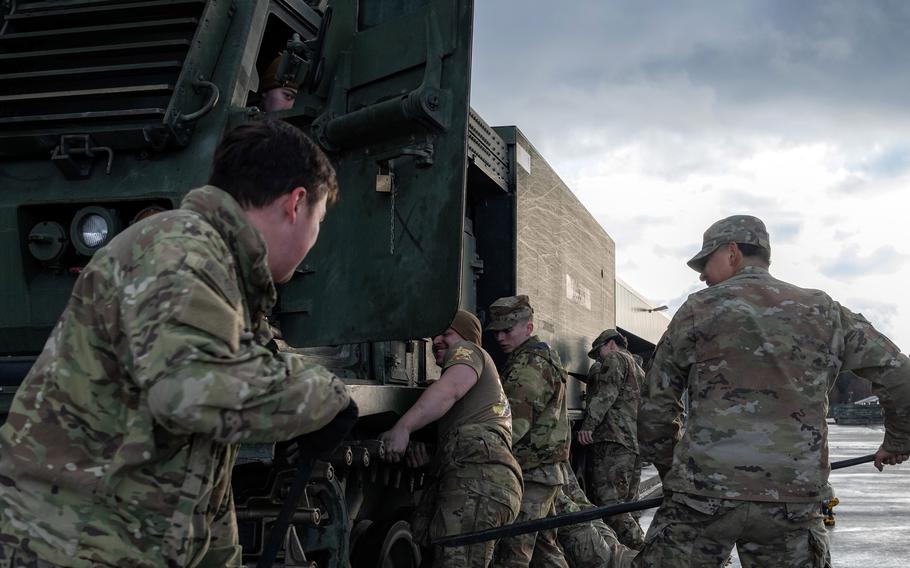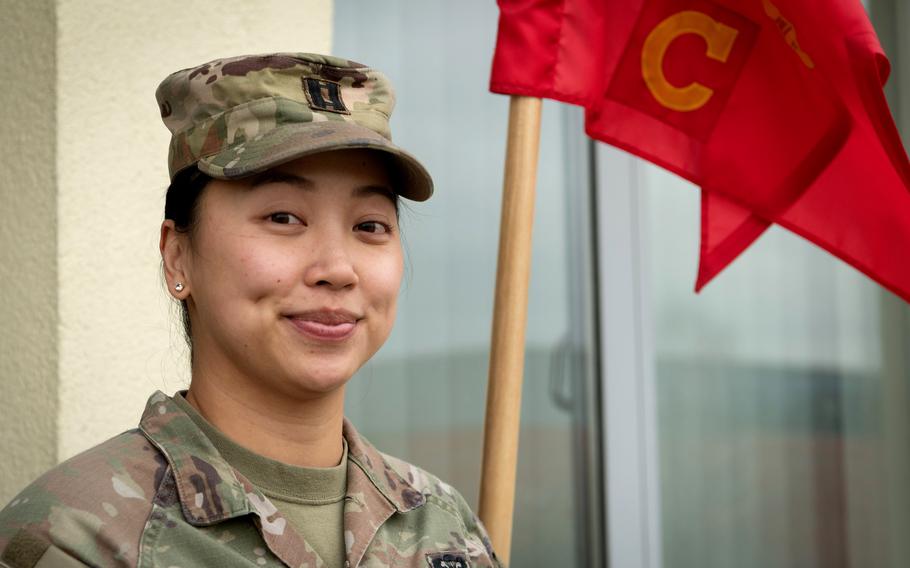
Soldiers assigned to 1st Battalion, 6th Field Artillery Regiment lift a new track into place on an Multiple Launch Rocket System in Grafenwoehr, Germany, on Feb. 1, 2024. (Phillip Walter Wellman/Stars and Stripes)
GRAFENWOEHR, Germany — Army Capt. Phuong Quach started 2024 with a mission to stand up an artillery battery from scratch.
One of her easiest tasks so far has been choosing its motto: “first shot.”
Charlie Battery, 1st Battalion, 6th Field Artillery Regiment — which was reactivated here in Bavaria in January — traces its lineage to the first American military unit ever to fire a round in Europe.
“It just brings back the gravity of the situation,” Quach said of carrying on the legacy of the soldiers who fought during World War I.
The battery’s reemergence marks the start of a transformation of the only U.S. field artillery brigade on the Continent, one that will grow by some 250 troops and receive over 50 state-of-the-art rocket systems in the months ahead.

Capt. Phuong Quach, commander of Charlie Battery, 1st Battalion, 6th Field Artillery Regiment, at the Army's Grafenwoehr Training Area in Germany on Feb. 1, 2024. (Phillip Walter Wellman/Stars and Stripes)
The changes come amid ongoing concerns from NATO allies, particularly the former Soviet states in the Baltics, that Russian President Vladimir Putin’s territorial ambitions won’t end in Ukraine.
Moscow would be emboldened further if Congress ends funding for Ukraine’s defense, Pentagon spokeswoman Sabrina Singh told reporters Tuesday.
“Putin is not going to stop in his quest for power and control beyond Ukraine’s borders toward NATO,” Singh said. “If Putin attacks a NATO ally, we will find ourselves in direct conflict, as we are committed to defending every inch of NATO.”
U.S. military leaders say their growing artillery arsenal is aimed at deterring Russia. But deterrence means training as if war were imminent.
Quach’s battery falls under the 41st Field Artillery Brigade, which was reactivated in 2018.
The brigade is equipped with the M270A1 Multiple Launch Rocket System, a mobile armored launcher that can drive across battlefields. It has two pods that can shoot either 12 rockets or two ATACMS guided missiles with a range of up to 190 miles.
When the brigade stood up, its two battalions were required to have two batteries with eight launchers each, a configuration that was established decades ago when the military was focused on counterinsurgency.
But a shift in focus to large-scale combat operations led officials to revise that configuration to three batteries with nine launchers each per battalion.
Charlie Battery’s reactivation is part of the new setup. As more units are added, the 41st FAB will have about 70% more firepower than it does now.
“This is a huge gain in capability,” said Lt. Col. Benjamin Roark, commander of 1st Battalion, 6th Field Artillery Regiment. “We’re doing this because it’s truly the future. You just have to look several hundred miles to our east to see the fight is with long-range precision missiles.”
Russia is using such missiles regularly to destroy Ukrainian cities and infrastructure. The deadly tactics of the past two years have driven NATO planning to strengthen air defense and its own long-range attack capabilities.
Besides adding launchers, the 41st FAB plans to upgrade them all to the latest variant, the A2, by this fall.
Artillery units in North Carolina and South Korea are undergoing similar changes. But 41st FAB commander Col. Wilbur Hsu believes the conversion underway in Europe is most crucial.
“Given the current strategic environment, and world events, having M270A2s here in Europe is an absolutely essential part of the deterrent for the European alliance,” Hsu said.
The feeling that the mission carries added importance is palpable at the brigade’s motor pools. On a recent drizzly afternoon, a group was replacing the worn-out track of a rocket system vehicle, using all their might to lift the new track into place.
There’s a heavy focus on maintenance within these units. If an attack occurred in Europe that required long-range strikes, there’s a good chance these soldiers would be called on first to respond, said Command Sgt. Maj. Tyler Bell of 1st Battalion, 6th Field Artillery Regiment.
“We are extremely relevant now and there is a large sense of pride here because of that,” Bell said.
Many of the battalion’s troops who reenlisted chose to extend their time in Bavaria with the unit instead of taking incentives to go elsewhere, which is a testament to their pride and belief in the mission, Bell added.
Quach hopes to instill the same feelings in her battery’s soldiers, who could number nearly 80 by the end of the year. Right now, there are only three. She and the other two soldiers spend much of their time doing the unglamorous work of readying inventory and making sure incoming soldiers and their families will be ready for life at Grafenwoehr.
Quach is confident that learning about the unit’s storied history will help build cohesion among the newcomers.
In December, shortly before assuming her command, Quach and other soldiers visited Bathelemont, France, where on Oct. 23, 1917, Sgt. Alex Arch of Charlie Battery, 6th Field Artillery used a French 75 mm artillery piece to fire the first American shot of WWI.
The Army was organized primarily into regiments at the time. Both the 1st and 3rd battalions of 6th Field Artillery Regiment trace their lineage back to Arch’s unit, which was led by Capt. Idus McLendon. The 3rd Battalion is based at Fort Drum, N.Y.
“They were relevant then and they have a place in history,” Roark said. “Now, as we do this transformation, we continue with that relevance.”